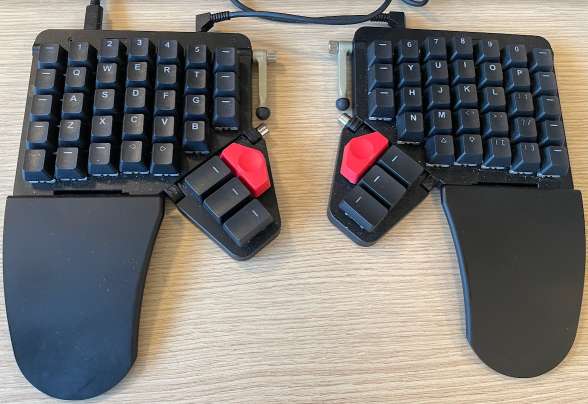I don’t know about you, but I hate using the mouse. The entire concept of a mouse is not productive. I’m supposed to move my hand to a different place, nudge something with accuracy, and click a button. I’m getting tired just thinking about it. I’d argue that unless you’re doing design or graphics, you can get by with just a keyboard. Most certainly as a software developer. Well, an occasional mouse contact might be required to browse a website and whatnot, but you’ll be better off without it for most things.
Let me explain exactly why you’re better off using mostly the keyboard. There are two main reasons. The first one is productivity. You can be much more productive using just the keyboard with the right work flow, software, hardware, and knowledge.
The second reason is ergonomics. Using a mouse adds more stress to your muscles, which can become a problem if you’re using the computer for many hours a day. I got repetitive strain injury (RSI ) from mouse use, so getting used to the keyboard was a necessity for me.
But even if you’re certain that the mouse is your friend and you’re happy with your computer use, I guarantee that if you try the following tips, you’ll become more productive. You might still use the mouse, but you’ll be able to do a whole lot of things much faster. So without further ado, let’s see how you can become more friendly and efficient with the keyboard.
1. Blind Typing
Blind typing (aka touch typing) is the most important skill to get the most out of a keyboard. As the name implies, it’s the ability to type without looking at the keyboard. Every finger is responsible for a specific set of buttons, which means you can better develop your muscle memory, type faster, and more accurately.
I was developing software for a decade before learning blind typing, and let me tell you, it’s a huge difference. It’s not just that I type faster, though I do, it’s mostly that I don’t do as many mistakes. Before blind typing, I had to re-type every other word. Now I barely touch the backspace button. I’d say my typing speed has at least doubled. Blind typing encourages proper hand positioning and spreads pressure among all your fingers. More importantly, it’s great to show off in front of other engineers.
There are plenty of apps and websites to learn blind typing, but I liked TypingClub . Be warned, it takes a long time to get the hang of it and then even more so to do it without thought.
2. Find the shortcuts in your most used applications
If you aren’t accustomed to shortcuts, you’d be surprised how many of them are there, especially in developer tools like Visual Studio. You can do anything in those apps without touching the mouse and with less effort. Here’s a life hack: go right now to ChatGPT and type “Most useful shortcuts in Visual Studio Code”. Then repeat this step for every tool you’re using intensely. I promise you, it will be helpful. If there aren’t many shortcuts in the applications you’re using, go ahead and find other applications.
3. Master OS shortcuts
By OS shortcuts, I mean the shortcuts built into Windows, Mac, and Linux. This starts with basic text editing shortcuts like Ctrl + [left/right arrow] to navigate between words, Ctrl + [del/backspace] to delete words, and Ctrl + Shift + [left/right arrows] to highlight. Some other useful ones are WinKey + V for a clipboard stack and WinKey + Shift + S to take a screenshot. I wrote this blog post
about cool shortcuts in Windows.
4. Get desktop versions of everything
Desktop apps allow you to use more shortcuts. Those pesky browsers tend to have their own key bindings that get in the way. I myself have a desktop version of WhatsApp, Notion, Outlook, and Teams. This allows me, in WhatsApp for example, to use Ctrl + Tab and Ctrl + Shift + Tab to move between chats. The same goes for Teams or Outlook. Sometimes, there are great shortcuts in web apps as well, including Gmail
(which are off by default) and Excel Online
.
5. Get friendly with the command line
I found that as I got faster with the keyboard and more familiar with command-line tricks, the cmd is faster in many use cases, like working with git or doing file operations. Besides, it’s widely accepted that engineers that use the command line are cooler. With time, you’ll get so used to the command line that you’ll start berating other engineers. That’s when you know you’re an expert.
6. AutoHotKey
AutoHotKey
is a scripting tool for Windows that allows you to bind keyboard shortcuts to scripts. For example, you can create a script that opens an app, executes a batch command, clicks buttons, copies to the clipboard, launches a website, or whatever. I work a lot with Windows Remote Desktop, so I set Ctrl + CapsLock to get out of RDP mode. I also got a shortcut to connect to a VPN, and another one to open the command-line in my main project’s folder. I don’t suggest going overboard with this, but adding some simple scripts for operations that you do many times a day is priceless.
Hotstrings
is another cool feature of AutoHotKey. Kind of like Visual Studio snippets, you can create your own abbreviations that work in all apps. For example, when I type iiuc, it changes to If I understand correctly. And typing vsc changes to Visual Studio Code.
7. Try a mechanical keyboard
You probably can’t understand until you’ve tried it, but a mechanical keyboard is more fun to click. Something about the clicking sound or the physical feedback.
A lot of those keyboards are more ergonomic; there are curved keyboards , split keyboards , keyboards with pedals , and keyboards where you barely have to move your hands . Here’s my ZSA Moonlander keyboard :

A mechanical keyboard is also a great conversation starter.
Many such keyboards, including mine, are programmable. You might have noticed that there aren’t any captions on keys that aren’t letters or numbers. That’s a feature, not a bug. You can arrange your keys in any way you want, as well as have multiple keyboard “layers”. In my keyboard, there’s a layer that acts as a “Numpad”, and another layer that controls the mouse. Yes, I can use the mouse with my keyboard, which is great for quickly scrolling with the mouse wheel or doing single clicks on the same button (e.g. click on the ‘go to next difference’ button in a pull request). By the way, you can achieve the same effect with a regular keyboard and AutoHotKey .
8. Use keyboard-friendly software
Some tech is better suited for the keyboard. For example, I use Markdown (with Typora ) for all my writing, which means I don’t have to do something distasteful like clicking on a ribbon button with the mouse. Not that I’m unable to use a program like Word with keyboard shortcuts, but markdown is just better. Another example is various diagrams and charts. With Mermaid , you can describe diagrams in text, which has a lot of advantages over classic charting tools (e.g. history, easier edits, standardization) and it doesn’t require using the mouse. I also suggest moving to a Norton Commander clone like FreeCommander , which is full of shortcuts and provides a better browsing experience than File Explorer.
9. Extra credits: Start using Vim
I admit, I don’t use Vim myself (it’s on my to-do list), but I admire Vim experts at work. It’s the ultimate keyboard productivity tool, with amazing ways to navigate and edit text. Vim has commands and shortcuts to move the cursor, search for patterns, or edit several lines at once. For example, you can create a command script that goes over each line in the file, jumps to the line’s end, and adds a semicolon. Or insert a new line after each } character in the entire file. Vim users have the topmost bragging rights in my book.
Summary
I realize that my suggestions aren’t for everybody. Most of the tips above have a steep learning curve and require hours of practice. Unfortunately, there aren’t many shortcuts in life (pun intended), but this work comes with rewards. It’s a question of whether it will be worth it to you. I think two main motivators might cause you to make the effort. The first one is ergonomics. All of the given suggestions will get you to do stuff in fewer clicks and with less strain on your hands. The second motivator is situations when you find that you’re thinking faster than you’re doing. That might be when you’ve spent two hours creating a diagram that you can draw on a piece of paper in 2 minutes (use Mermaid ). Or if you’re spending an hour every morning mousing your way through Outlook and Teams (it’s time to discover new shortcuts and learn to type faster). If you’re ever suspecting you’re not using the most productive tool for the job, you probably aren’t. Happy typing everyone.





